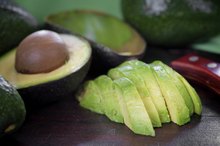Symptoms of Lactose Intolerance in a Toddler
Any toddler might have gastrointestinal symptoms occasionally. When your child has them on a regular basis, however, it could be related to diet. Lactose intolerance is a deficiency in the enzyme toddlers need to break down the milk sugar called lactose. Symptoms of lactose intolerance are far more likely to occur in older children and adults, but toddlers can experience temporary or ongoing lactose intolerance symptoms such as gas and diarrhea.
Increased Gas
Excessive abdominal gas is a common symptom of lactose intolerance in a toddler. When a carbohydrate such as milk sugar is not digested in the small intestine, bacteria in the large intestine break it down, producing gas. Increased gas could cause your little one to have a noisy stomach with a lot of gurgling. If your child's abdomen looks distended or she frequently passes large amounts of gas after drinking milk or eating milk products, it could be related to lactose intolerance.
- Excessive abdominal gas is a common symptom of lactose intolerance in a toddler.
- If your child's abdomen looks distended or she frequently passes large amounts of gas after drinking milk or eating milk products, it could be related to lactose intolerance.
Diarrhea
The Signs of an Obstructed Bowel in a Toddler
Learn More
Diarrhea is hallmark symptom of lactose intolerance. Lactose that is not properly digested and absorbed remains in the colon, where it attracts fluid. The excess fluid makes the stool watery, leading to sudden, intense bouts of diarrhea with lots of gas. This can cause even a potty-trained toddler to have accidents. The stool passed tends to be more acidic than a normal bowel movement, which can cause skin irritation. Your toddler may complain of a sore bottom or start scratching her bottom because of this skin irritation.
- Diarrhea is hallmark symptom of lactose intolerance.
- The stool passed tends to be more acidic than a normal bowel movement, which can cause skin irritation.
Abdominal Discomfort
Abdominal cramps or pain can also indicate lactose intolerance in a toddler, especially if they occur relatively soon after eating. Some toddlers may experience nausea, although vomiting is uncommon. Symptoms can occur within as little as 30 minutes of eating or drinking high-lactose foods. A toddler with lactose intolerance can often tolerate a small amount of dairy products -- especially in a form such as cheese or yogurt -- eaten with a meal containing other foods and will have no symptoms. If your toddler develops gas and diarrhea shortly after she has a large glass of milk on an empty stomach, however, it could be because of lactose intolerance.
- Abdominal cramps or pain can also indicate lactose intolerance in a toddler, especially if they occur relatively soon after eating.
Considerations
What to Feed a One-Year-Old for Constipation
Learn More
Some degree of lactose intolerance is common as children reach their teens and adulthood. In a September 2006 policy statement, the American Academy of Pediatrics notes that, by adulthood, approximately 70 percent of the world's people have some level of lactase deficiency. The condition, however, is much less common in toddlers. The AAP statement points out that lactose intolerance is uncommon in white children younger than 5, but approximately 20 percent of Hispanic, Asian and black children exhibit symptoms before age 5. The AAP does not recommend eliminating milk products for toddlers or children with lactose intolerance, but it does suggest controlling the amount and type of dairy products in their diet. If you suspect your child may have lactose intolerance, talk with your doctor about the next steps for diagnosis and treatment.
- Some degree of lactose intolerance is common as children reach their teens and adulthood.
- The AAP does not recommend eliminating milk products for toddlers or children with lactose intolerance, but it does suggest controlling the amount and type of dairy products in their diet.
Related Articles
References
- Pediatrics: Lactose Intolerance in Infants, Children, and Adolescents
- American Academy of Allergy, Asthma & Immunology: Food Allergy -- A Practice Parameter
- The Merck Manual for Health Care Professionals: Gas-Related Complaints
- The Merck Manual for Health Care Professionals: Carbohydrate Intolerance
- US National Library of Medicine. Lactose intolerance. Medline Plus. 2019.
- National Institutes of Health. Lactose Intolerance. Genetics Home Reference. 2019.
- Borghini R, Donato G, Alvaro D, Picarelli A. New insights in IBS-like disorders: Pandora's box has been opened; a review. Gastroenterol Hepatol Bed Bench. 2017;10(2):79-89.
- Szilagyi A, Ishayek N. Lactose intolerance, dairy avoidance, and treatment options. Nutrients. 2018;10(12). doi:10.3390/nu10121994
- Johns Hopkins Medicine. Lactose intolerance.
- KidsHealth from Nemours. Lactose intolerance. 2015.
- UW Integrative Health. The elimination diet. School of Medicine and Public Health University of Wisconsin Madison.
- Dekker PJT, Koenders D, Bruins MJ. Lactose-free dairy products: Market developments, production, nutrition and health benefits. Nutrients. 2019;11(3). doi:10.3390/nu11030551
- Cleveland Clinic. Gas: management and treatment. 2016.
- Ferreira-lazarte A, Moreno FJ, Villamiel M. Application of a commercial digestive supplement formulated with enzymes and probiotics in lactase non-persistence management. Food Funct. 2018;9(9):4642-4650. doi:10.1039/c8fo01091a
- Ferreira-Lazarte A , Moreno FJ , Villamiel M .Application of a commercial digestive supplement formulated with enzymes and probiotics in lactase non-persistence management.Food Funct. 2018 Sep 19;9(9):4642-4650. doi: 10.1039/c8fo01091a.
- Varjú P, Gede N, Szakács Z, Hegyi P, Cazacu IM, Pécsi D et al. Lactose intolerance but not lactose maldigestion is more frequent in patients with irritable bowel syndrome than in healthy controls: A meta-analysis.Neurogastroenterol Motil. 2019 May;31(5):e13527. doi: 10.1111/nmo.13527. Epub 2018 Dec 17.
Writer Bio
Beth Greenwood is an RN and has been a writer since 2010. She specializes in medical and health topics, as well as career articles about health care professions. Greenwood holds an Associate of Science in nursing from Shasta College.









